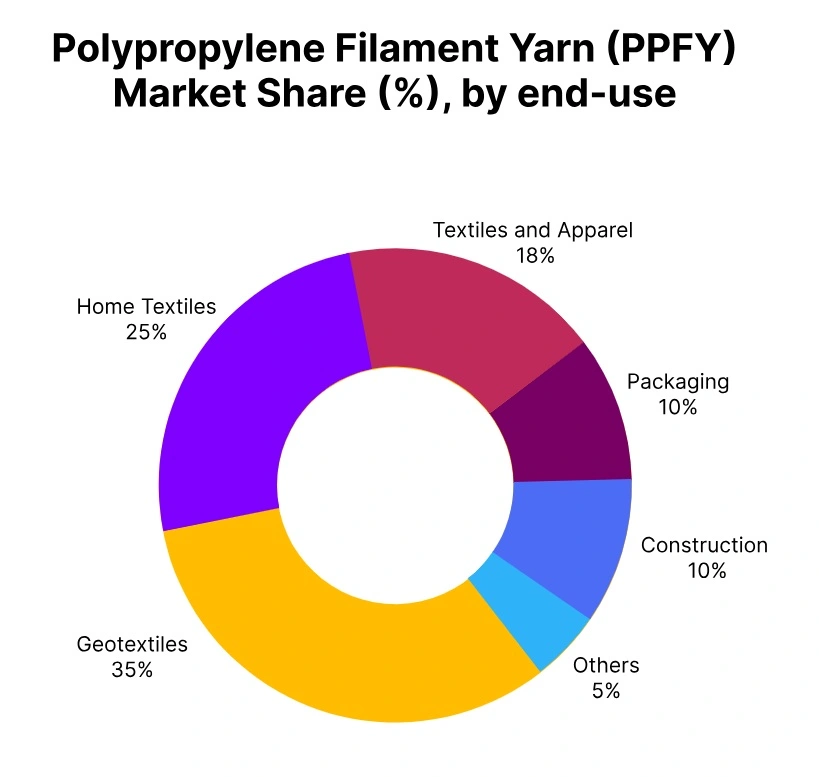Price-Watch’s most active coverage of Polypropylene Filament Yarn (PPFY) price assessment:
- 840D Twisted Ex-Ahmedabad, India
- 840D Twisted FOB Mundra, India
- 840D Twisted CIF Asuncion (India), Paraguay
- 840D Twisted CIF Sohar (India), Oman
- 840D Twisted CIF Port of Djibouti (India), Djibouti
- 840D Twisted CIF Colombo (India), Sri Lanka
- 840D Twisted CIF Mombasa (India), Kenya
Polypropylene Filament Yarn (PPFY) Price Trend Q3 2025
In Q3 2025, the global Polypropylene Filament Yarn prices saw a decreasing trend by around 1%, driven by decreased propylene feedstock costs, competitive offers from producers, and subdued consumption in textile, carpet, and industrial sectors.
Polypropylene Filament Yarn (PPFY) price trend in September 2025 reflected brisk negotiation and lean restocking, while regional price declines happened by currency movements and variable freight rates, particularly in export routes from India.
India (Domestic: Ahmedabad)
Polypropylene Filament Yarn (PPFY) Domestic prices Ex Ahmedabad, India, Grade- 840D Twisted.
Polypropylene Filament Yarn prices in India followed a downward price trend during Q3 2025, shifting down by 1% from the previous quarter. The Polypropylene Filament Yarn (PPFY) price trend in India reflected a landscape where textile and industrial users reduced contract volumes due to ample market supply and slow demand from converters.
Selective restocking ahead of the festive season played a pivotal role in maintaining stability, while key trading approaches ensured new orders stayed conservative as feedstock costs adjusted downward. In September 2025, Polypropylene Filament Yarn prices in India ranged from USD 1400 to 1500 per metric ton, as buyers emphasized inventory discipline and responded to evolving end-use sentiment.
India (Export: Mundra)
Polypropylene Filament Yarn (PPFY) Export prices FOB Mundra, India, Grade- 840D Twisted.
According to Price-Watch, Polypropylene Filament Yarn price in India for exports moved along a mild downward price trend in Q3 2025, with export values dipping by 1.5% compared to Q2. Across the quarter, the Polypropylene Filament Yarn price trend in India’s export channels revealed adaptable contract negotiation and timely booking as exporters balanced global competition, changing currency rates, and average offshore demand from carpet and technical fabric buyers.
In September 2025, Polypropylene Filament Yarn export prices in India settled between USD 1450 and 1550 per metric ton, underpinned by currency movements and responsive pricing strategies configured to ongoing international market shifts.
Paraguay
Polypropylene Filament Yarn (PPFY) Import prices CIF Asuncion, Paraguay, Grade- 840D Twisted.
Polypropylene Filament Yarn price in Paraguay demonstrated a clear downward price trend in Q3 2025, dropping about 4% quarter on quarter. The Polypropylene Filament Yarn price trend in Paraguay was driven by strong sourcing from Indian suppliers as freight reductions and a weakening INR enhanced landed cost advantages.
Importers increased inventories for carpets, bags, and industrial textile applications, assisting in securing favourable deals and maintain flexible procurement. In September 2025, Polypropylene Filament Yarn prices in Paraguay remained attractive, as strategic supply chain adjustments and ongoing cost management sustained lower offers for buyers.
Oman
Polypropylene Filament Yarn (PPFY) Import prices CIF Sohar, Oman, Grade- 840D Twisted.
Polypropylene Filament Yarn prices in Oman reflected a stable downward price trend during Q3 2025, dipping by 3–4% from the previous quarter. The Polypropylene Filament Yarn price trend in Oman was influenced by falling propylene costs, moderate freight reductions, and another phase of INR weakening.
Buyers for packaging and industrial yarns benefited from advantageous order timing, while September 2025 market activity centered on exploiting more competitive international pricing and careful inventory building.
Djibouti
Polypropylene Filament Yarn (PPFY) Import prices CIF Port of Djibouti, Djibouti, Grade- 840D Twisted.
Polypropylene Filament Yarn prices in Djibouti tracked a consistent downward price trend in Q3 2025, declining by 3% from the previous period. The Polypropylene Filament Yarn price trend in Djibouti displayed the effect of stable freight, prudent inventory management, and a weaker rupee, which together ensured lower procurement costs for downstream textile and bag producers. Demand for September 2025 prioritized adaptive purchasing strategies and disciplined price negotiation, helping to reinforce regionally competitive offers and flexible supply.
Sri Lanka
Polypropylene Filament Yarn (PPFY) Import prices CIF Colombo, Sri Lanka, Grade- 840D Twisted.
Polypropylene Filament Yarn price in Sri Lanka adopted a gentle downward price trend in Q3 2025, slipping by 3–4% as market softness extended from Q2. The Polypropylene Filament Yarn price trend in Sri Lanka mirrored the influence of a slight freight drop, a softer rupee, and buyers’ preference for replenishing inventories at the lowest possible landed costs.
September 2025 procurement showed vigilant monitoring of international price shifts as local geotextile, textile, and consumer goods manufacturers looked for efficient and economical sourcing options.
Kenya
Polypropylene Filament Yarn (PPFY) Import prices CIF Mombasa, Kenya, Grade- 840D Twisted.
Polypropylene Filament Yarn price in Kenya echoed a modest downward price trend for Q3 2025, easing by around 2–3% for the quarter. The Polypropylene Filament Yarn price trend in Kenya reflected a market shaped by rising freight but partially offset by a softer INR combined with careful inventory management by local packagers and matting makers.
For September 2025, competitive buying and active attention to logistics and currency changes prevailed, preventing sharper price declines and supporting disciplined procurement throughout the trading cycle.



